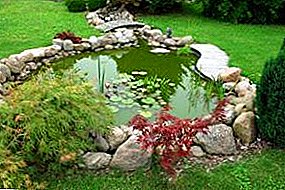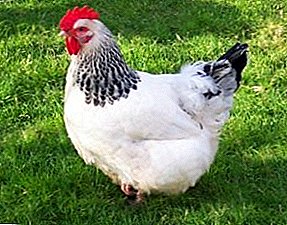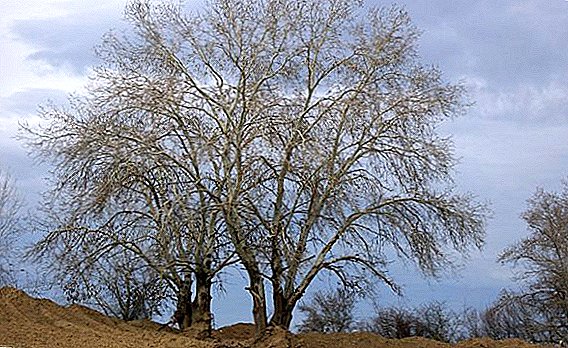
Almost all gardens have a reservoir. It must be added to the frame: the owners like their own pond, they consider it the main garden achievement and are proud of it. All this is understandable, but to a rather strict professional to inspect the reservoir, as are the annoying blunders in its creation. Mistakes are offensively consistent in many gardens.
Let's analyze some typical mistakes and consider how to make a waterfall, stream or decorative pond in our own garden.
Wrong size
 The most common mistake is that the created reservoir does not fit the surrounding plants and the garden in size. Often it turns out a small puddle, which is located at the entrance to the garden or near the fence, which is clamped from all sides by beautiful and lush garden plants. But it all looks pathetic.
The most common mistake is that the created reservoir does not fit the surrounding plants and the garden in size. Often it turns out a small puddle, which is located at the entrance to the garden or near the fence, which is clamped from all sides by beautiful and lush garden plants. But it all looks pathetic.
Required to correlate the size of the reservoir with the surrounding space. This does not mean that the creation of a small reservoir will not allow to decorate the garden. When choosing a particular image, you should optimally choose the size. If in the garden there is no place for a large pond, then you can try to make a miniature pond.
Badly selected location
You can not dispose of a pond on the background of a leaning fence, heaps of garbage, sloppy garden and unsightly buildings.
Water attracts the eye, so you should not have your own body of water in unsightly places, since attention will be focused on garden faults.
Slips in the choice of material
 When purchasing materials for the arrangement of the garden, it is necessary to proceed from the law of similarity. If the house is built of stone or brick, then their size, shape, texture and color should be repeated in the material of decoration, paving, fence of other buildings. This refers to the house covered with siding or the house of wood.
When purchasing materials for the arrangement of the garden, it is necessary to proceed from the law of similarity. If the house is built of stone or brick, then their size, shape, texture and color should be repeated in the material of decoration, paving, fence of other buildings. This refers to the house covered with siding or the house of wood.
It is important that the reservoir harmoniously fit into the surrounding space. You can often see that the private garden corners are very nice.: beautiful plants are logically grouped, the pond is decorated carefully and with fantasy - and the general impression of the garden remains negative.
When analyzing, it turns out that the house is made of red brick and has white plastic windows, a powerful fence is assembled from prefabricated concrete blocks, it has been painted in a bright pink color with white festoons on top. In addition, there is a carved gazebo in the garden, to which an asphalt walkway leads, colored colored plastic borders are used, and flowerpots are installed everywhere. In this case, no comment.
From this we can conclude: if you are engaged in the arrangement of the garden, then when adding any new elements to it, it is necessary to model the final result in advance.
Losing the fight against the plastic form
Often there is a misconception that the best choice when creating a reservoir is a finished plastic form. Now manufacturers offer a huge range of such "trays" of any shape. But here everything is difficult.
If you use the largest possible size, then this will not be enough for the garden, and small forms have the appearance of a misunderstanding. With obviously small sizes, a rather intricate form is obtained that will not seem natural..
At the edges of these forms, a rounded profile is used, where it is impossible to fix gravel, soil and stones for coastal plants. In some of the more expensive options, a wide quartz sprinkling on the upper edge is glued. Often it is very different from the available local materials, and it does not work out to decorate.
 In the manufacture of plastic forms used stamping method. Cheap products have an annoying defect in the form of a bias on the periphery of the edges. Because of this, for any efforts, it will not be possible to evenly and accurately dig this form.
In the manufacture of plastic forms used stamping method. Cheap products have an annoying defect in the form of a bias on the periphery of the edges. Because of this, for any efforts, it will not be possible to evenly and accurately dig this form.
The presence of a sticking piece of black plastic will destroy all your efforts. You can compare this reservoir with a luxurious dress, in which a carelessly sewn lining in the most conspicuous place spoils the whole look. At the very least, this will be regrettable.
To transport a large form is quite expensive and not easy. As a result, the final price of the facility increases significantly.
Hard forms have a future. For several years in Europe they have been producing plastic forms with regular geometric outlines: trapezoidal, rectangular, round. They are distinguished by a wide, flat, horizontal edge, which provides a convenient installation method for all kinds of flooring.
It is advisable to use them for formal raised reservoirs, which are quite effectively decorated with metal, plastic, wood and stone. They are located at different levels and are perfectly combined with waterfalls and fountains.
Before choosing one or another method of waterproofing, it is necessary to familiarize yourself with the pros and cons of each option and conduct a comparative analysis. The lack of data on the quality of materials for waterproofing in the presence of a huge market offer can lead to wrong decisions.
Stone beads
 The most common mistake when decorating a garden pond is a rounded cobblestone, which is laid like beads around the edge. Often, these beads are in the same row, but some manage to settle them in several rows.
The most common mistake when decorating a garden pond is a rounded cobblestone, which is laid like beads around the edge. Often, these beads are in the same row, but some manage to settle them in several rows.
This way of laying stone will never have a natural look.. In this case, it is impossible to decorate the board of a rigid structure or a film. And so on the monstrous black banks there are multi-colored "monists", and the aqua-garden will be a silent reproach for the owner.
While relaxing on the shore of lakes and rivers, pay attention to exactly how nature "lays out" the stones. Highlight the most memorable and favorite options. Small fractions are used for the background, and larger - for the selection of contrast groups.
It is necessary to carefully select the stone for decorating the reservoir.. You can use a homogeneous stone in color and rock, but different in size.
Toys around the pond
Another typical flaw that can spoil a carefully thought out and most beautiful design is the simultaneous use of a large number of different garden accessories and decorative toys in a small area.
Some funny elves and bright gnomes are able to decorate certain garden corners and bring a smile. But if there are quite a lot of clay mermaids, papier-mâché ducks and plastic frogs, inevitably a brute force will occur. These items are attractive in themselves, but if they are collected in one place, they will turn the garden into a haberdashery shop.
Reckless use of jewelry violates the garden harmony. It is necessary to look at the garden from the side in order to spread decorative “gadgets” in time and space.












